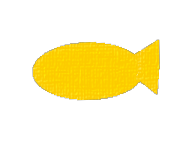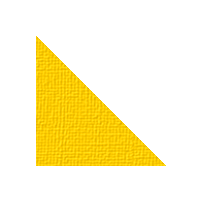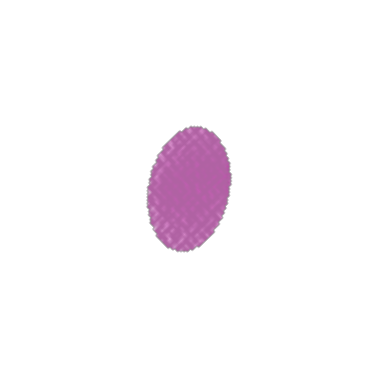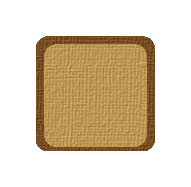Understand Kids' Mealtime Experiences: The Stamp Plate Project
“Make Mealtime Fun and Meaningful” — The Stamp Plate Project
Duration
June 2018 - Jan 2019
My Role
User Research
UX & UI Design
Interaction Design
Digital & Physical - Prototype
Wizard of Oz testing
Key Deliverables
Concept Development Visual Design
Interaction Flows
Working Prototype
Tools
Adobe Illustrator
Protopie
Laser Cutter
Background
Led by Ph.D. Candidate Ying-yu Chen, this research project explores the role of technology plays in various relationships between parents and young children at family mealtimes. You might wonder, why mealtime specifically? Mealtimes are important not only for young children’s nutritional intake but also for providing them with ways to foster healthy eating habits and good table manners. However, children's food pickiness and mealtime tantrums are impairing these processes and add stress to parents. We realize that there are phenomena that parents are rejecting using technology intervention, especially in the mealtime context. Therefore, our research group wants to uncover the reasons behind parents' rejections and wonder if there is any potential for technology solutions to support young children’s and families’ mealtime practices.
The main Kids' Mealtime Project consists of several connected subprojects including the Stamp Plate that explores young children eating habits and speculatively design mealtime technology to foster a better mealtime manner. As the only UX designer who joined the Stamp Plate team later (after the primary research phase), I was responsible for carrying the research findings to the later design phase.
Design Goal
This project begins with understanding how kids age 2-6 eat with their caregivers. During the primary research phase, we conducted observations and gathered understandings of eating habits among young children that would help to inform design sketches and prototypes. Through rounds of ideations and down-selection processes, we finally built a creative tablet application, the "Stamp Plate" and deployed the application with families. Using the "Stamp Plate", we aim to explore the opportunities for technology to better support kids' mealtime experience, potentially, in a fun and playful way.
Understand Children's Mealtime Practice
To design technology for children's mealtime, we need to fully understand the space including current young children's mealtime practice and parents' perspectives. We first conducted field studies both in children's preschools and in homes. The Kids' Mealtime group went to two preschools, the university Montessori and a federally funded program to observe children's eating routines and learned their values at mealtimes. From observations, we noticed these tensions between teachers and children (Chen, 2019, p. #):
- Sitting Still vs. Comfort: Teachers feel the room is under control and not considered as chaos though kids are moving around while eating.
- Using Utensils vs. Autonomy: Children ignore teachers' reminders and instructions on how to use utensils correctly.
- Cleanliness vs. Creativity: Kids love building and playing with anything on hand, including food while teachers see these as violations of hygiene.
And we also observed a total of 8 homes of families with at least one child aged between two to six during mealtime and interviewed one parent following dinner. Children under parent's close monitor showed less creative and playful eating behavior than school visits. From home visits, we noticed some similar concerns that spanned all families and therefore, summarized four goals that parents care about during mealtimes (Chen, 2019, p. #):
- Healthy Eating Habits: Parents would spend significant time and labor on exploring ways to increase children's likelihood of eating a mixture of diverse, nutritious foods.
- Eating More Food: Parents use a variety of tactics to encourage their children to at least finish the food on their plates, and find it challenged to make them eat more.
- Table Manners: Parents find it hard to keep children sit still while eating.
- Mealtime Conversation: Parents want to leverage mealtime as an opportunity for conversation and bonding, and push this kind of activity even when kids are reluctant to communicate.
From school and in-home visits, we were able to have a generative empirical understanding of children's and caregivers' values and goals in terms of mealtime practice. While caregivers perceive mealtimes as an opportunity to teach children values, life skills, and build bonds with them, young children tend to enjoy interacting with food in multiple creative ways. These observations serve as an inspiration for designing technology for mealtime.
Understand Parent's Perspectives on Mealtime Technology
Mealtime Technologies include screens, voice interfaces, and smart objects product. To understand how parents felt about using technology during mealtime, the group created a total of 12 storyboards using speculative design thinking to explore design opportunities that align with parents' goals. Presenting different types of technologies including speculative screen-based designs, voice interfaces design, and smart objects design in different eating contexts, parents were prompted to tell us how they feel about each of these designs in the survey. We got a total of 122 participants who answered the survey.

[Fig 1] Example of a storyboard created by the Kids' Mealtime group memebers
According to the survey, parents pushed back on some scenarios and expressed concerns that can be categorized into these four top-level categories (Chen, 2019, p. #):
- Control: Technology shouldn't tell children what to do.
- Dependence: Children might build reliance on the certain proposed design, which leads to more problematic technology use.
- Distraction: Technology being a distraction and splits children's attention from the main task which is eating.
- Intrusion: Technology takes control over jobs that are supposed to belong to the parents.
Avoid being controlling, dependent, distracted, and intrusive are the design principles we kept in mind while ideating desired design outcomes.
Design Mealtime Technology
After rounds of design ideations, following the design principles, three ideas, the Cat Fork (see Fig 2a), the Stamp Plate (see Fig 2b), and the Kicking Chair (see Fig 2c) were derived from the three value tensions (1. Siting Still vs. Comfort, 2. Using Utensils vs. Autonomy, and 3. Prioritizing Cleanliness vs. Creativity) found in previous observations.
The Cat Fork: This idea consisted of a metal fork (the cat paw) and plate (the cat face) that represent a cat. A colorful light would (there are a total of 10 color lights) lit up when the kids touch a certain section (the cat's eye, nose, mouth, and whiskers) of the plate using the cat paw-like fork. The rationale behind this design idea was to support the child's utensil use with fun visual feedback (Chen, 2019, p. #).
The Stamp Plate: This idea consisted of different types of stamps that correspond to food items eaten off the plate, leaving behind silhouette-like shapes that create food-inspired illustrations. When food such as goldfish-shaped crackers is picked up from the plate, a small fish shape will show up on the plate (Chen, 2019, p. #). The rationale behind this design idea was to keep food on the plate and potentially incentivize children to eat more in order to have more food stamps show up.
The Kicking Chair: This idea consisted of the chair with a long elastic band wrapped around the two front legs of the chair. Kicking the band triggers a playful sound play. The rationale behind this design idea was to keep the children sitting on their chairs (Chen, 2019, p. #).
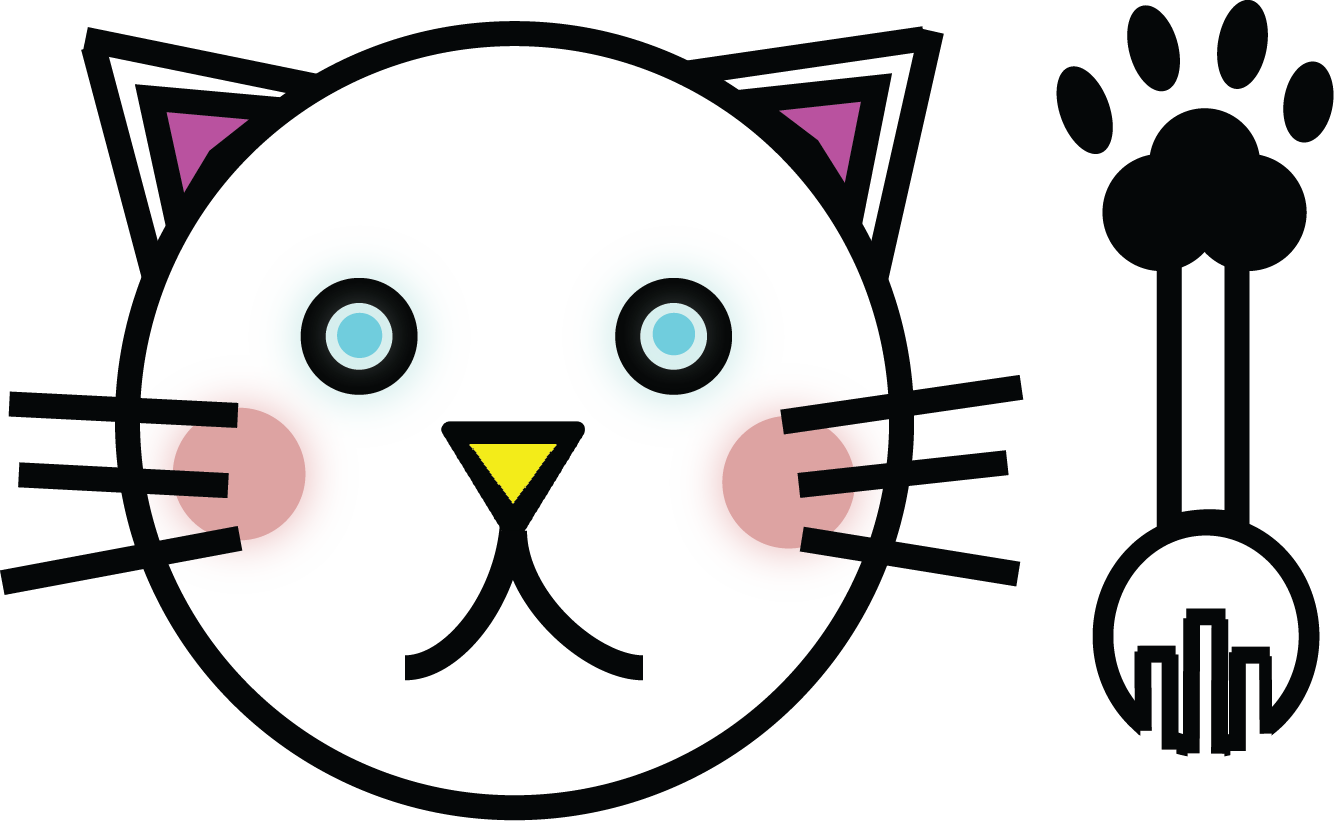
[Fig 2a] Cat Fork Idea
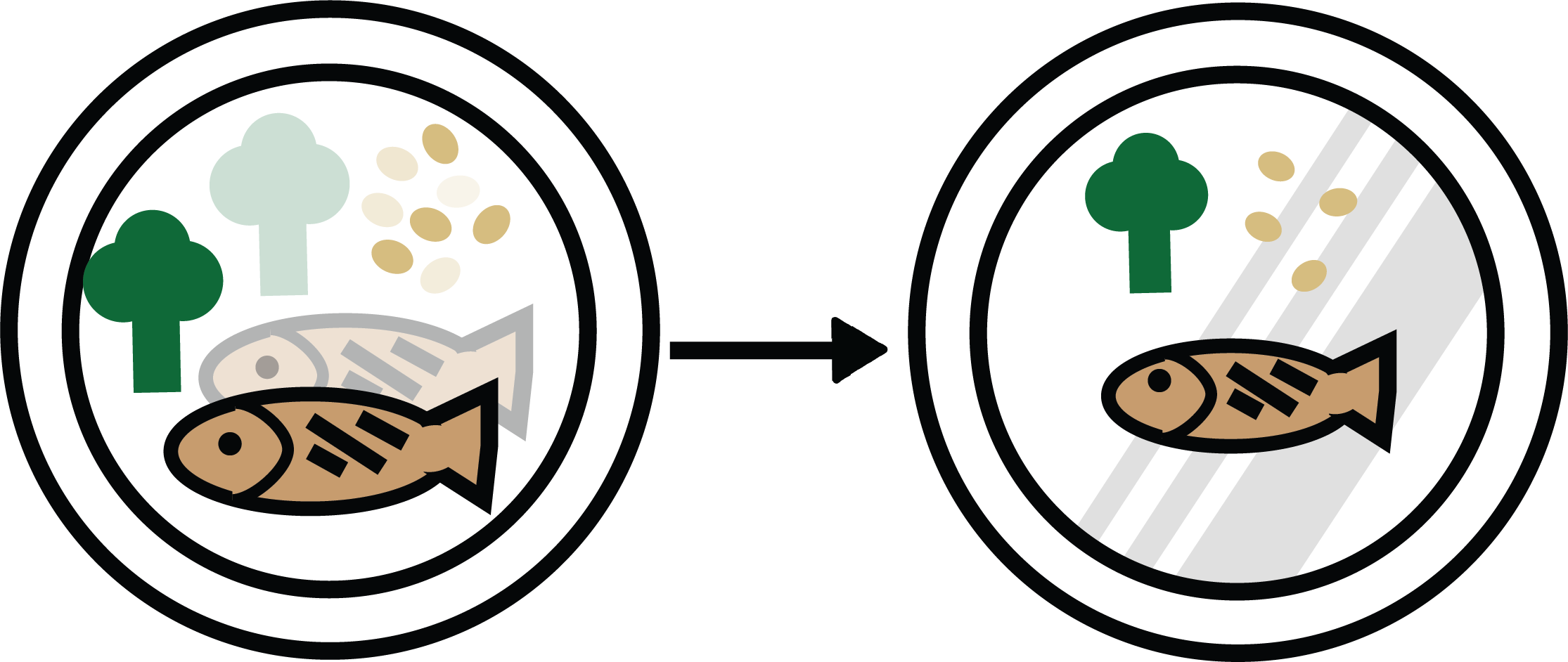
[Fig 2b] The Stamp Plate Idea
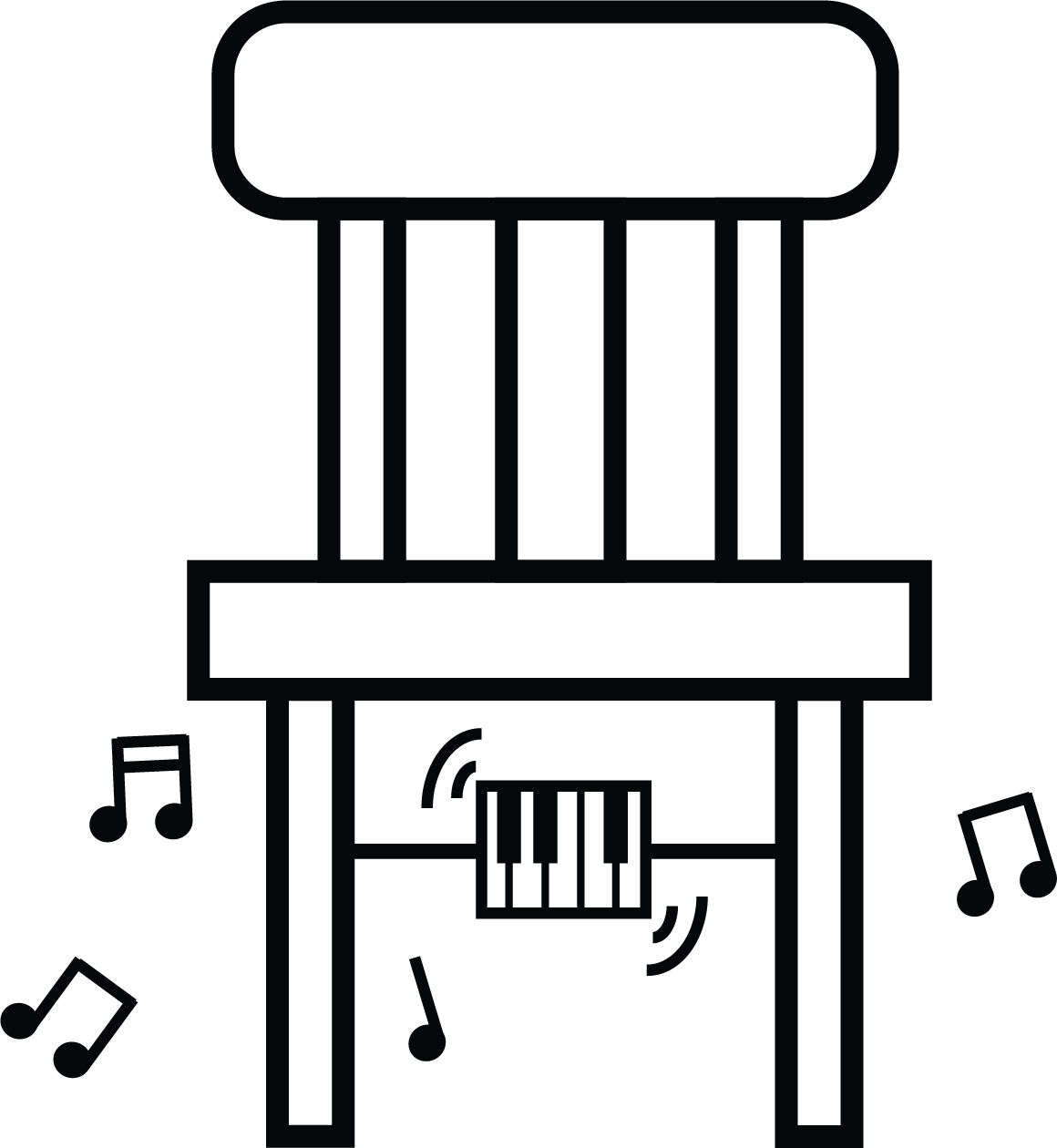
[Fig 2c] Kicking Chair Idea
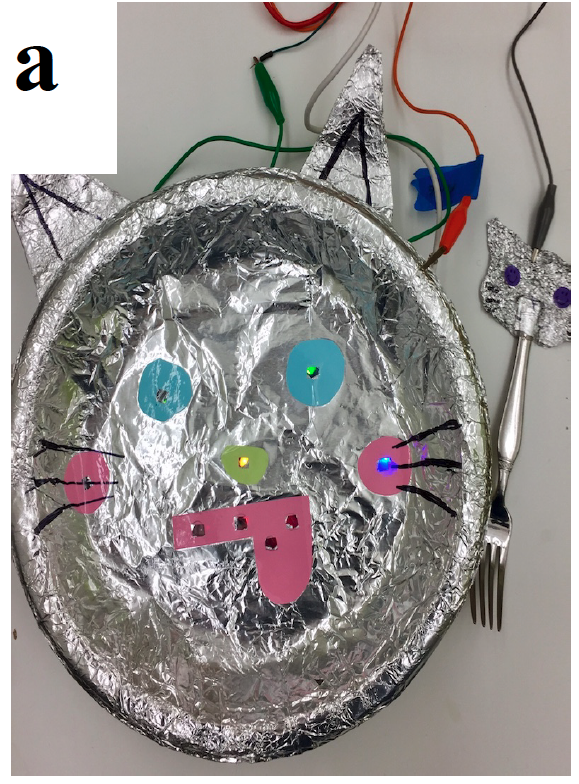
[Fig 3a] Cat Fork Idea Prototype
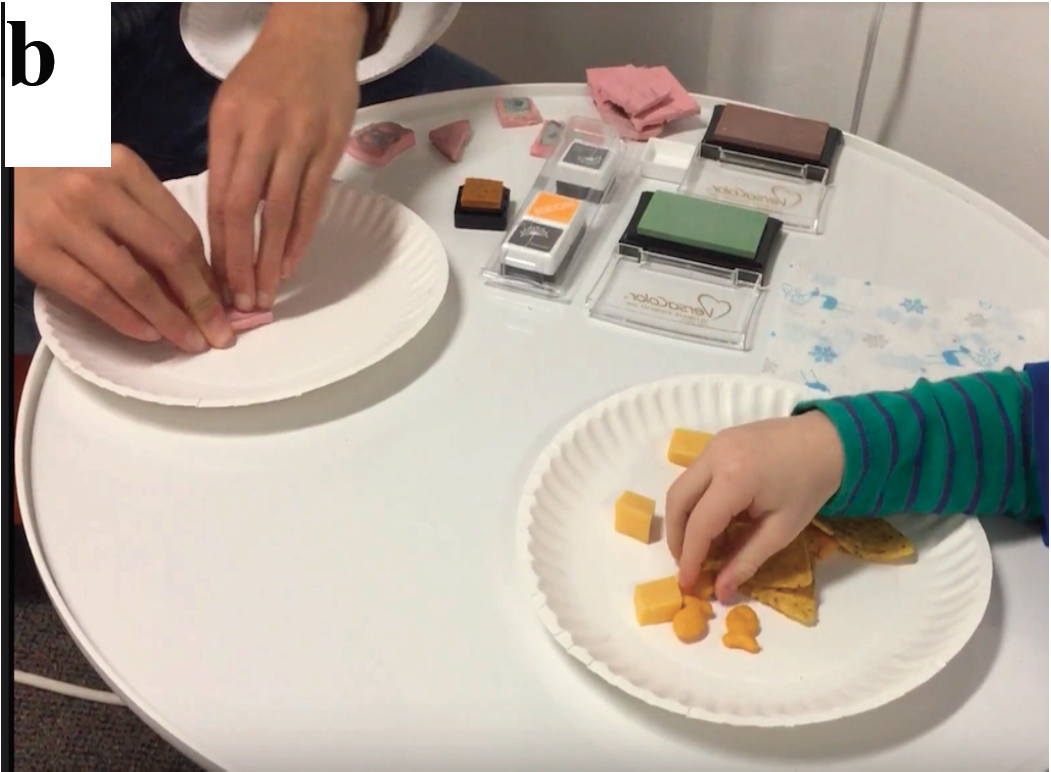
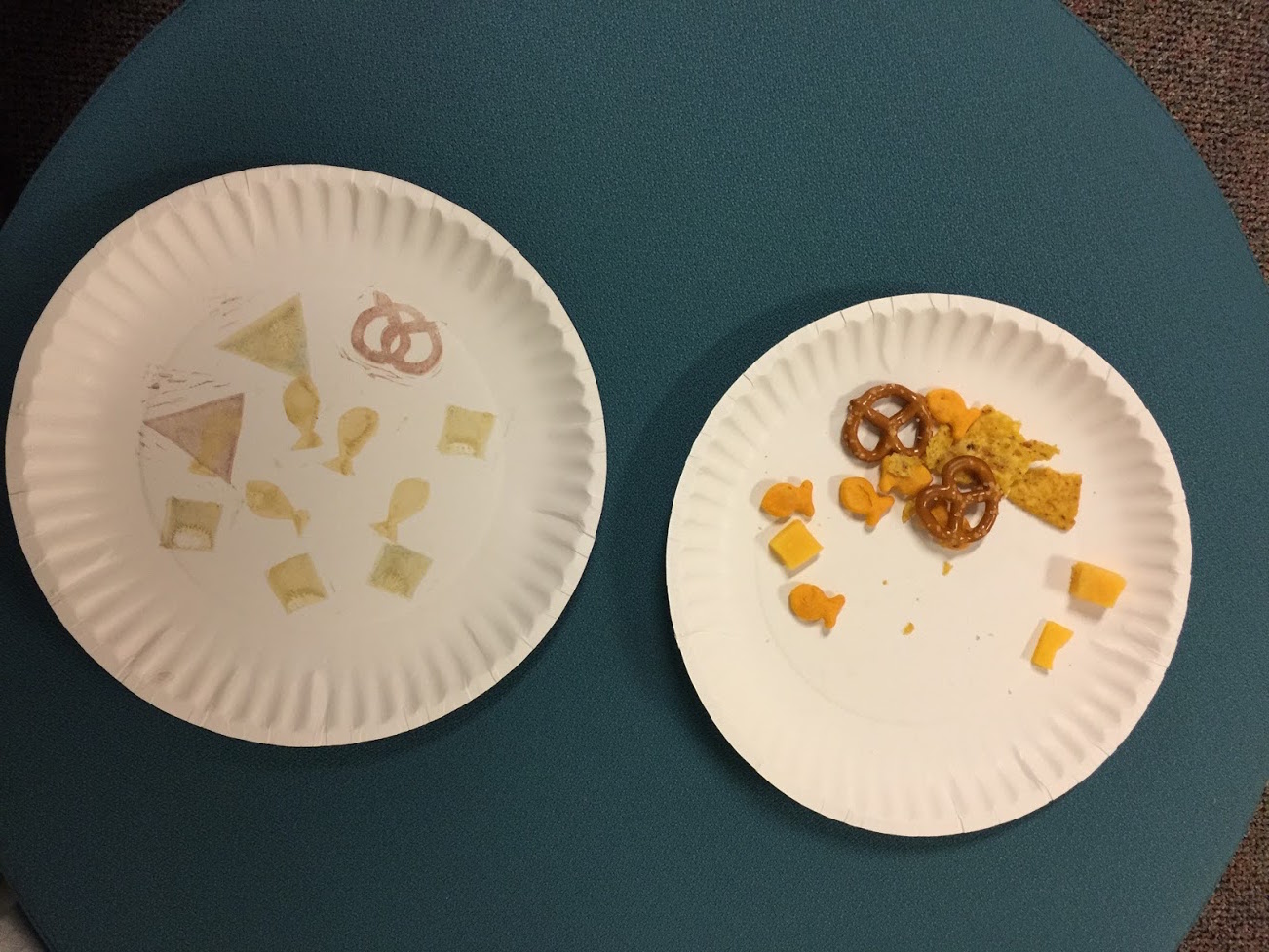
[Fig 3b] The Stamp Plate Idea Prototype
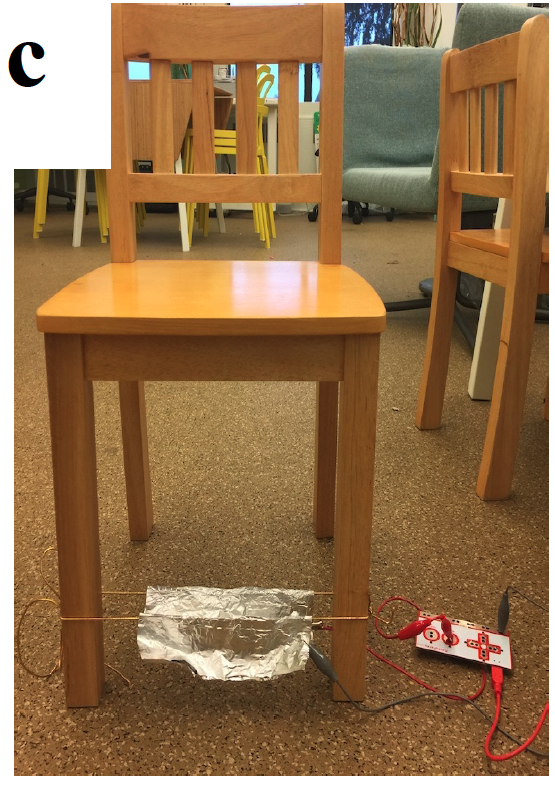
[Fig 3c] Kicking Chair Idea Prototype
The Stamp Plate
Let's start with a demo video before we dive into the Stamp Plate :)
This video is a demo for the Stamp Plate, the interactive plate that playfully tracks and visualizes the food placed on top of it and later eaten off of it in the form of stamps. In this video, both program and user interface are designed only for the initial demo. The tablet is connected with a weight sensor controlled by the Arduino board. * More details will be discussed in the later prototype section.
Initial Food Stamp Design
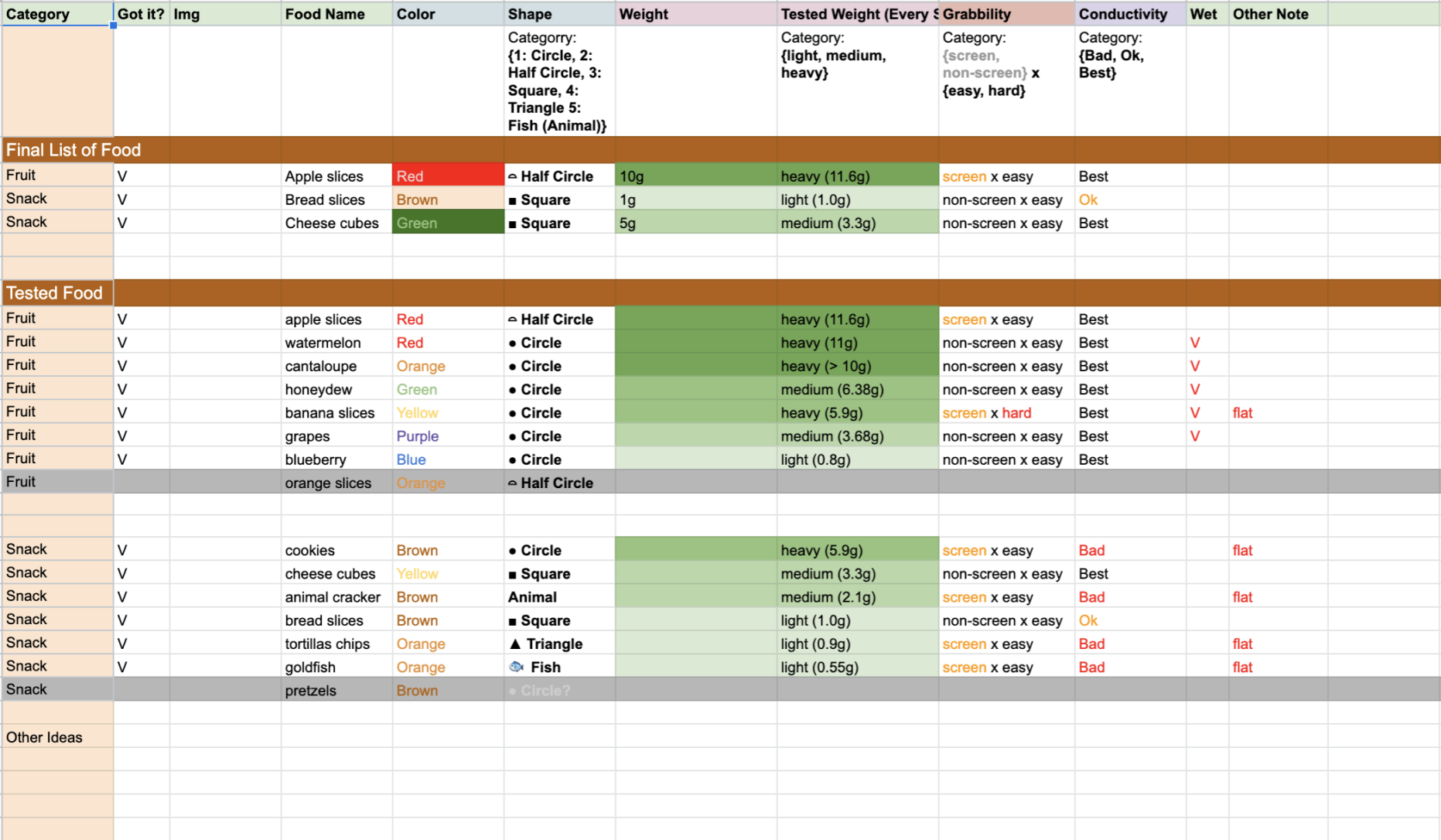
[Fig 2] Food Item Sheet
In the demo, we use cookies to represent food. When we decide on food options for the later usability testing, we consider that since our study has kids involving eating activity, we do not want to prepare food such as cookies that are high in sugar so we decide to go with healthy fruits and snacks.
Initially, we used broccoli, grape, and goldfish crackers and I designed these initial stamps for internal piloting. But after a couple of rounds of piloting, we found out that the crackers and grapes are too light to be detected by the sensor. And the broccoli made the screen watery. So we decided to change the food to slice apples, bread cube, and cheese out of the consideration of food's weight, grabbility and conductivity



